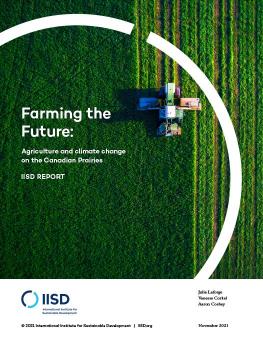
Farming the Future: Agriculture and climate change on the Canadian Prairies
What does the future of farming on the Canadian Prairies look like under climate change? This report summarizes climate risks to, and impacts from, agriculture in the Canadian Prairies. It looks at “sweet spot” solutions that can increase producers’ resilience, improve economic viability, and contribute to Canada’s climate change mitigation goals.
-
Agricultural GHG emissions in Canada are 12% of the national total.
-
The Prairies face a number of critical risks, from flooding to heat waves and invasive pests, that could jeopardize agricultural productivity and producer livelihoods.
-
Many on-farm practices can increase resilience and long-term viability of Prairie farming operations while also reducing emissions, but they require increased policy support and public investment.
On the Canadian Prairies, modern farms are caught in the cross-currents of multiple fundamental changes, including a decline in the number of farms, an increase in average farm size, growing fertilizer and pesticide use, and the rising costs of inputs, land, machinery, and other expenses. On top of these, climate change will fundamentally affect the future of farming in the region.
The Prairies face a number of critical risks, from flooding to heat waves and invasive pests, that could jeopardize agricultural productivity and producer livelihoods. Producers may also be affected by the impacts of climate policies in export markets and changing consumer behaviours in response to climate change concerns.
Canada’s agricultural producers have a complicated relationship with climate change that goes beyond simply feeling impacts or adapting to them. The way we farm also has impacts that are large scale enough to matter in Canada’s broader greenhouse gas emission profile. Agriculture in the Prairies contributes 64% of all Canadian agricultural emissions. Across Canada, agricultural emissions are 12% of the national total.
The good news is that we already know how to reduce emissions through beneficial management practices (BMPs), many of which have benefits such as reducing input costs or helping producers to adapt. Many farmers have already adopted certain BMPs, including no-till. But government policy plays a critical role in supporting farm-level changes, and much more is needed to spur the adoption of climate-friendly practices.
This report summarizes climate risks to, and impacts from, farming on the Prairies. It examines the types of BMPs that could be beneficial and looks at gaps and opportunities in current federal and provincial policy to support their adoption. It also proposes next steps for how governments, industry and non-governmental organizations can support Prairie producers to move toward a new, more economically, environmentally, and socially sustainable vision of Prairie farming.
Participating experts
You might also be interested in
How Can We Work With Nature to Tackle Drought and Desertification?
Drought is one of the most devastating and pervasive challenges exacerbated by climate change. However, we can work to reduce its effects through nature-based solutions for land restoration and climate-smart agriculture.
For Nature-Based Solutions to Be Effective, We Need to Work with Indigenous Peoples and Local Communities
Nature-based solutions have been praised as a promising approach to tackling the twin crises of climate change and biodiversity loss. But some Indigenous Peoples and local communities are questioning the legitimacy of the concept and what it symbolizes. It is time to listen to what they have to say.
How Fossil Fuels Drive Inflation and Make Life Less Affordable for Canadians
New report takes closer look at how Canada’s dependence on fossil fuels impacts energy costs and prices of essentials such as transportation, home heating, and housing.
Why Liquefied Natural Gas Expansion in Canada Is Not Worth the Risk
An analysis of the economic and environmental risks of liquified natural gas expansion in Canada.